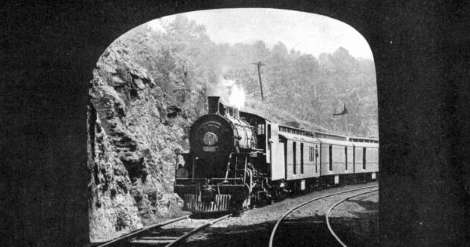In the late 1800s, industrialization boomed and fast shipping was a key to success. A town without a railroad faced big competitive disadvantages. Thus the idea of the Burlington and Hinesburg Railroad was born in 1890.
In November of that year the Vermont Legislature granted a charter to the Chittenden County Railroad. The planners began imagining the prosperity that would soon come to the area, then dominated by farming.

Train entering a tunnel.
The founders of the new railroad came from some of the more prominent names in town: Leonard Andrews, postmaster; C.G. Peck, son of a former senator and Isaiah Dow, owner of the Hinesburg Woolen Mill.
The Burlington and Hinesburg
The plan for the railroad was to run it up from Hinesburg through Shelburne, Williston, St. George and into South Burlington where it could connect with the Burlington and Lamoille Railroad. Railroads were expanding rapidly and competing for the market share to carry products and people from even tiny corners of the country to and from the larger cities.
A railroad, the local merchants thought, would be the perfect solution to make Hinesburg competitive in shipping its textiles, lumber or other products.
For nearly 15 years the work proceeded. The name of the road was changed from Chittenden County to the Burlington and Hinesburg and surrounding towns even made inquiries into how they might get the railroad into their villages.
A Look Around Chittenden County published by the Chittenden County Historical Society includes a letter from Col. Ellsworth Lawrence to his family in Hinesburg. He happily notes that he has a plan for a new product to be created at the family farm:
“I believe there is blue clay in paying quantities suitable for making pottery, tile, etc. – any amount of it over in the southwest corner in the south meadow.
“You and I will have to go over there pretty soon and we will investigate and if we find the clay – why then all we will need to do is to go to working on pots and tile, and ship them out on our new railroad to market.”
Working on the Railroad
Work proceeded with the railroad negotiating rights of way, grading road beds, installing culverts and buying land for a railroad station. In 1903, the Burlington and Southeastern Railroad bought the line. It had even bigger plans to add a spur north and another all the way to Windsor.
In 1905, the dream died, with more than $100,000 spent, almost all its track bed graded, and four miles of actual track laid, the dream died. The railroad ran out of money. Its treasurer signaled the company could not possibly succeed. The railroad fever finally broke.
All that was left was a series of track beds, many of which have been bulldozed. Some, however, remain today, as historian Gerry Fox explained in a 2015 lecture.
This story was updated in 2024.


1 comment
[…] marriage between Cordelia and Ezra Smith, benefiting from Vermont’s growing economy, seemed cordial and peaceful – an appearance that was never […]
Comments are closed.